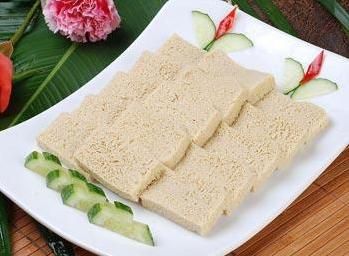The nutritional value of frozen tofu
Frozen tofu is frozen tofu. Thawed and dehydrated dried tofu, also called sponge tofu, has a water content of less than 1% and is easy to store.
Frozen tofu is the invention of the northerners. It is the use of frozen tofu. The frozen tofu has undergone physical changes. There are innumerable small holes inside the tofu. These holes are of different sizes, some are interconnected, and some are closed into small "containers", which are filled with water. We know that water has a strange characteristic: at 4°C, it has the largest density and the smallest volume; when it reaches 0°C, it forms ice, and its volume is not reduced but swells, which is more than the volume of water at normal temperature. To be about 10% larger, when the temperature of the tofu drops below 0°C, the moisture in the tofu becomes ice, the original hole is propped up by the ice, and the whole tofu is squeezed into a network shape. After the water ran away from the tofu, it left countless holes, making the tofu become like foam. The taste of such tofu is very rich. It is very good to cook frozen tofu in a soup because the cellulite in the frozen tofu absorbs the soup. Frozen tofu is suitable for hot pot or frozen tofu. It is not difficult for the South to eat, and it is OK to put it in the refrigerator. It will take about one day for frozen tofu to appear. Of course, the most important thing is that all the soy products are more or less astringent. You can basically solve the astringent taste by boiled water before cooking.
nutrient content
Each 100 grams of frozen tofu contains nutrients as follows: calories (81.00 kcal) • protein (8.10 grams) • fat (3.70 grams) • carbohydrates (4.20 grams) • dietary fiber (0.40 grams) • thiamine (0.04 mg) ·Riboflavin
(0.03 mg) niacin (0.20 mg) vitamin E (2.71 mg) calcium (164.00 mg) phosphorus (119.00 mg) potassium (125.00 mg)
• Sodium (7.20 mg) • Magnesium (27.00 mg) • Iron (1.90 mg) • Zinc (1.11 mg) • Selenium (2.30 μg) • Copper (0.27 mg) • Manganese (0.47 mg)
